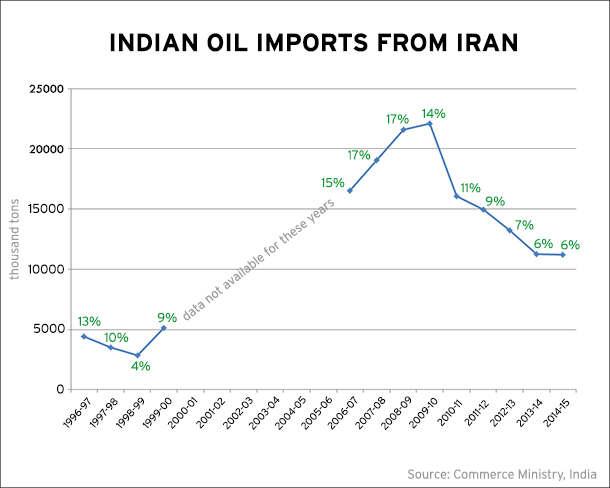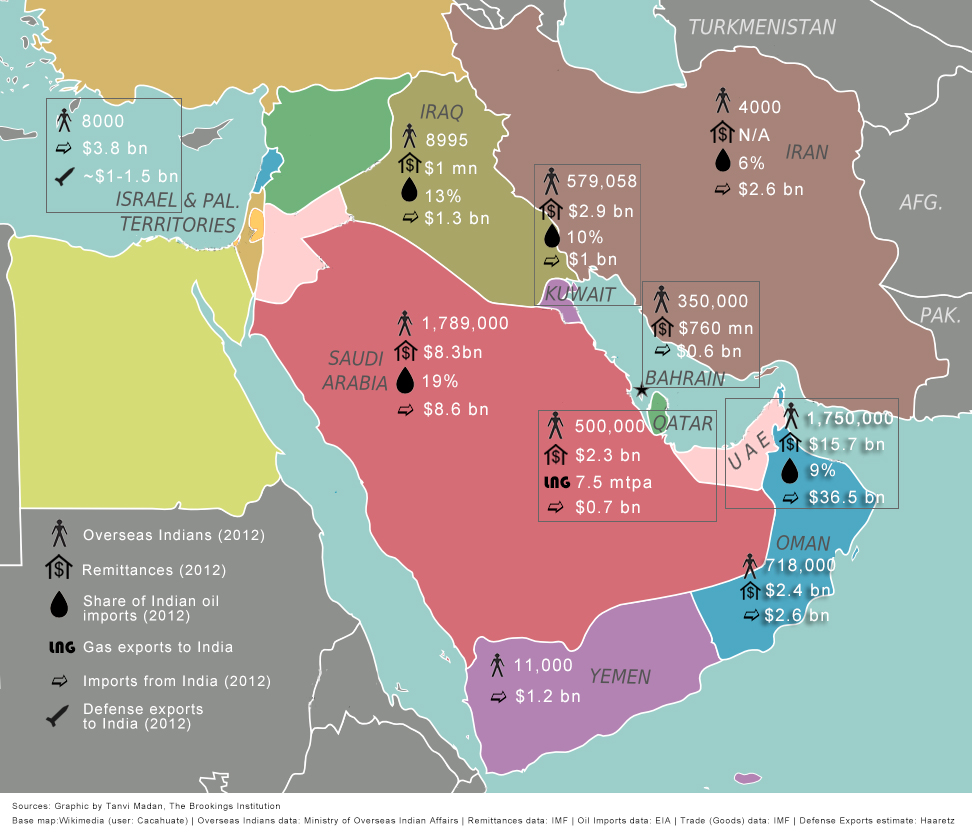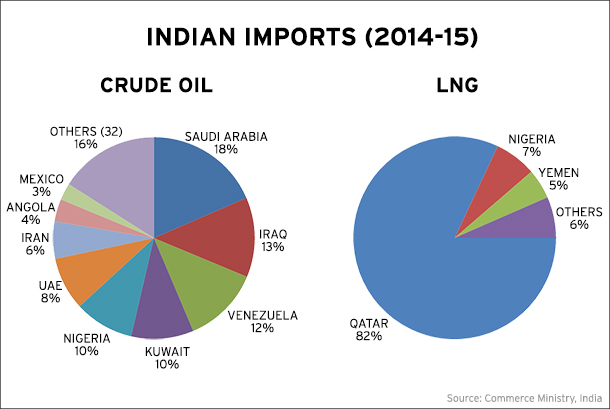The Indian government welcomed news of the Iran deal. A former Indian national security advisor described the accord reached as the “best deal available.” India has a complicated relationship with Iran, and its leaders will watch closely as implementation and the consequences of the deal play out. The deal could open up economic and strategic opportunities for India and thus it’s being seen mostly with hope; however, those hopes are tempered by some challenges and uncertainties.
In some ways, India has been preparing for a deal for several months, re-engaging Iran at the highest levels. Since February, the Indian national security advisor, transport minister and foreign secretary have traveled to Iran, and the foreign minister intended to do the same until her meeting was postponed. Most recently, Prime Minister Narendra Modi met with President Hassan Rouhani on the sidelines of the Shanghai Cooperation Organisation summit in Ufa, Russia last week. He reiterated an invitation for Rouhani to visit India and said he looked forward to visiting Iran as well.
Was delighted to meet President @HassanRouhani & talk to him about stronger India-Iran ties.
— Narendra Modi (@narendramodi) July 9, 2015
India never stopped engaging with Iran and some of the recent trips may have taken place even in the absence of the deal. There are certain imperatives for the relationship that make it important for India regardless (mentioned below). Furthermore, after spending its first year focused on India’s immediate neighborhood, the Asia-Pacific and the G-7, the Modi government has made clear its intention to “look west” over its second year, including with high-level trips to Central Asia (completed), Israel, Palestine, Jordan, and Turkey (for the G20 summit). This engagement becomes easier and more crucial for Delhi with the Vienna deal, which has implications for India in the energy, economic and geopolitical spheres.
Energy and economic ties
As the world’s fourth largest energy consumer that imports more than three-quarters of its oil and an increasing amount of its natural gas, India will watch with interest the deal’s impact on the energy market.
A few years ago, 17 percent of Indian oil imports were from Iran, which had become the country’s second largest supplier. Last year, Iran was seventh on the list, supplying only 6 percent of Indian oil imports.

India will hope to benefit directly and indirectly from Iranian oil coming on to the market in the short-to-medium term. It might import more oil from Iran, partly to keep its supplier base diversified – but to what extent will depend on the terms. India is better placed as a buyer now than it was even a year ago. A petroleum ministry official noted last week that “There is no dearth of crude oil in the world. Iran was attractive mainly because of its sops. The sops will now very likely disappear. So we will have to weigh if it makes economic sense to import from Iran.”
More importantly, India will perceive more Iranian oil on the market as giving it greater leverage with other sellers, including Saudi Arabia, its largest supplier by far. It will also hope this will mean a further reduction in global oil prices or, at the very least, those prices remaining steady. This might not be great for Indian oil producers, but its oil refiners will be happier – although they will have to pay up the $6.5 billion owed to Iran. The Indian government will be happier as well. Its import and subsidy bills, and the Modi government, have benefited greatly from the fall in oil prices over the last year: when Modi came to office, the price for the Indian crude basket was $108.05 per barrel; the day before the deal was announced, it was $57.19 per barrel.
While India has not imported natural gas from Iran and currently there’s no lack of gas on the market at better prices than before, this might be considered in the future. Here too, the terms will be crucial, as will Iran’s export and India’s absorptive capacity. The decades-old discussions around an Iran-Pakistan-India (IPI) gas pipeline might also be revived, although it would face competition from more recent talk of the Turkmenistan-Afghanistan-Pakistan-India or an undersea pipeline. Moreover, the problems of getting an IPI pipeline financed, insured and secured, as well as the gas priced right, mean that the project will require a lot of work before it materializes. China’s commitment to help build an Iran-Pakistan pipeline will also have to be factored in.
Indian oil and gas companies have been active in Iran in the past – albeit not without problems – and they will likely consider returning. State-owned oil and gas company ONGC has been trying to win the rights to develop a block in the Persian Gulf that it had discovered years ago. A delegation of petroleum ministry and state-owned energy company officials visited Iran in the spring to explore other opportunities. In the private sector, Reliance Industries, which had investments in and exported refined products to Iran, might also take another lookat upstream projects and the possibility of resuming exports of petroleum products. At its peak in 2008-09, India was exporting over $1 billion worth of petroleum products to Iran; after Reliance stopped exporting, there was a sharp decline in that figure to less than $50 million in recent years.
Some Indian corporates have already made a beeline for Iran; more will. They will face stiffer competition than they have in the past. In the upstream sector, Iran will be courting players from other countries, with access to more advanced technology. But, even if they can’t beat the rush or others’ terms, Indian companies could seek to be part of consortia, bringing to the table their familiarity with doing business in Iran.
There is some concern that Iran will drive a harder bargain on the energy front – an approach Indian official and corporate negotiators aren’t unfamiliar with. However, just as Iran now has more options, so does India. As one of the fastest growing consumers of oil and natural gas, in the context of an over-supplied market, India has more market power than it used to. Its diplomats will signal Tehran that excluding Indian companies won’t benefit the broader relationship.
Beyond the energy sector, India hopes for greater exports. Some Indian companies, who have been increasingly looking abroad, see Iran as a potential market for goods and services. One of India’s main chambers of commerce quickly expressed its “happiness” that a deal had been reached, with the hope that it would lead to Iran’s “return to the mainstream global economy.” Another said it would look into opening an office in Tehran. The extent of their interest and outreach will depend on how the market there develops and the competition they face. As for those Indian companies which have benefited from exporting to Iran through the sanctions period, they’ve already been expressing concern about the potential competition.
The strategic dimension: Geopolitics & geo-economics
Connectivity to Afghanistan and Central Asia. With Pakistan not a feasible transit option, the Indian government sees the potential for Iran to serve as a crucial transit route to Afghanistan and Central Asia, a region with which Modi advocated greater linkages during a recent visit. This interest – along with China’s role in a the port of Gwadar in Pakistan – has helped drive India’s desire to invest in upgrading the Iranian port of Chabahar . Discussions about Chabahar have been underway for over a decade and have started and stalled a number of times. But India has showed renewed interest in recent months with the prospect of a nuclear deal clearing key political and financial obstacles. While skeptics of the project remain, India is aiming to move it forward and its transport minister has expressed hope that the port will be operational by the end of 2016. The nuclear deal will be seen as facilitating this goal; it might also lead to greater interest in developing the transit corridor through Iran to Europe and Russia. The Iranian ambassador to India indicated that $8 billion worth of projects had been offered to India and urged it to take advantage of this “golden time.”
The drawdown of NATO troops from Afghanistan has made the Iran transit route—as well as greater India-Iran cooperation in and on Afghanistan—even more crucial for the Indian government. The two countries have worked together on Afghanistan, where they have had a common interest in limiting the Taliban’s role. The ongoing Pakistan-brokered talks between the Ghani government and the Afghan Taliban have increased concern in Delhi about greater Taliban influence in Afghanistan. This will enhance the incentives to cooperate with Tehran, and the deal might create more space for it. However, some analysts are skeptical about how much cooperation Iran might be willing or able to undertake.
The Middle East. India has maintained relations with every country in the Middle East (or what it calls West Asia). Its direct interests and connections with the Gulf Cooperation Council countries and Israel, in many ways, are broader and deeper than those with Iran.

India will continue to try to balance these relationships, hoping that the deal will create more diplomatic space for Delhi. Some in India have also pointed to the deal potentially opening the door to greater American and Iranian efforts to counter ISIL as a benefit.
On the other hand, if the deal destabilizes the region and especially the security situation deteriorates even further, that could have adverse implications for India. More than 7 million Indians live and work in the Middle East, and they send home significant remittances. Moreover, this region continues to be the major source of oil and natural gas for India, and any new conflict could threaten supplies and escalate prices. With large Sunni and Shia populations, the Indian government will also be concerned about the spillover from sectarian tension in the Middle East. Finally, significant heightening of tensions between its many partners in the region might require India to make some choices – so far it has preferred to avoid doing so.

Relationship with the U.S. If the deal is implemented, this will ease what has been a key cause of India-U.S. strain in the recent past. The U.S. Congress, in particular, has previously looked askance at India’s relationship with Iran and especially its oil imports. Indian energy companies like ONGC have also found themselves vulnerable to American sanctions because of their investments in Iran, limiting their ability to operate in the U.S. While they broadly share the goal of preventing Iran from getting a nuclear weapon, the effect that sanctions have had in curbing their choices has rankled with Indian policymakers, corporate leaders, and even the public. The potential lifting of the sanctions will thus remove one point of contention between India and the U.S. and potentially open up more space for cooperation in the region.
If Congress blocks the deal, however, this will be perceived negatively in India. It will also reinforce concerns about the U.S. ability to sanction countries unilaterally and the desire to explore alternative financial mechanisms. India, after all, has itself been the target of U.S. sanctions in the past, as has Modi.
The deal – and especially any upgraded U.S. engagement with Iran in the future – will reinforce India’s belief in its approach of engagement rather than isolation. With few exceptions (e.g. the apartheid regime in South Africa, the Taliban government in Afghanistan), Delhi has tended to work with whatever regime it finds in power. However, Washington has criticized India’s engagement with certain governments (e.g. the communist regime in Beijing in the 1950s and 1960s; Myanmar more recently) only to change its own approach toward them. While their American interlocutors might point to the U.S. approach causing or contributing to changing these states’ behavior, Indian officials will likely remain skeptical.
Overall, the deal, along with the rapprochement with Cuba, will likely also reinforce positive sentiments about President Obama in India. Recent American presidents have been popular with the Indian public. Prime Minister Manmohan Singh famously told President Bush that the “people of India deeply love you.” And, in 2006, 56 percent of Indians surveyed in a Pew poll had expressed confidence in Bush’s international leadership – higher than in any other country. But while they approved of his bilateral initiatives, especially the India-U.S. nuclear deal, other elements of the Bush administration’s foreign policy, especially the war in Iraq and the partnership with Pakistan, were unpopular. Obama, on the other hand, seems to garner approval because of his foreign policy, not despite it: in a recent Pew survey, 74 percent of the Indians polled in the spring expressed confidence that Obama would do the right thing in world affairs.



Commentary
India and the Iran deal
July 20, 2015